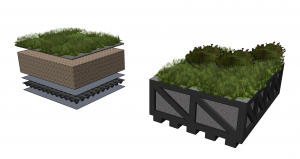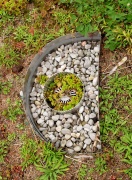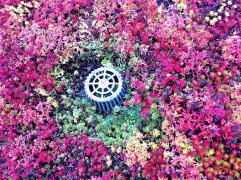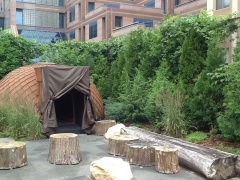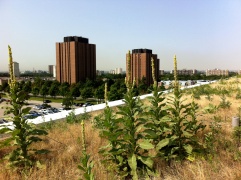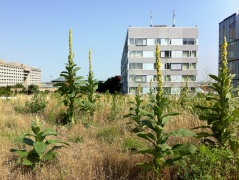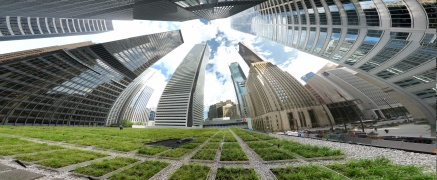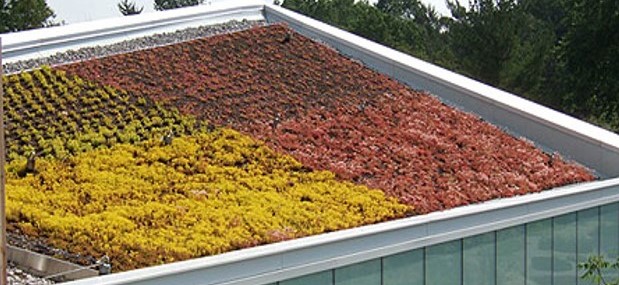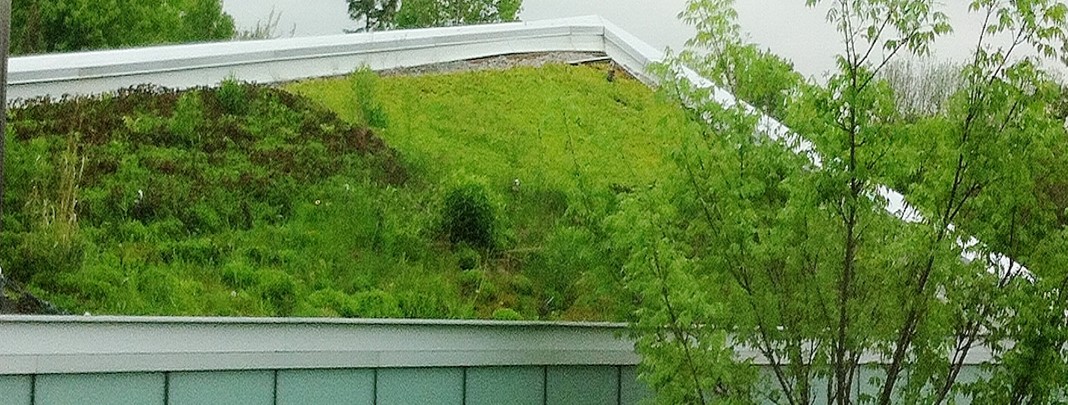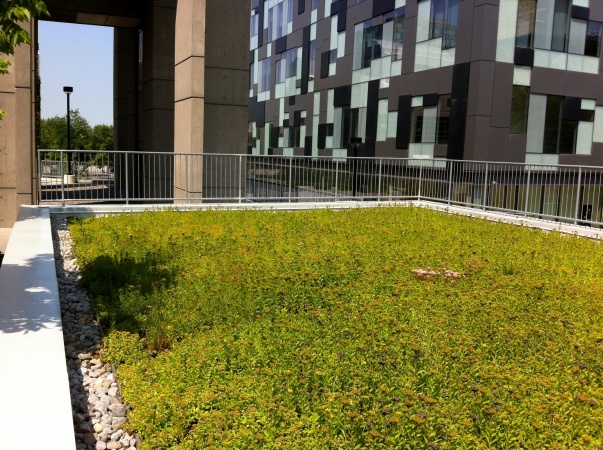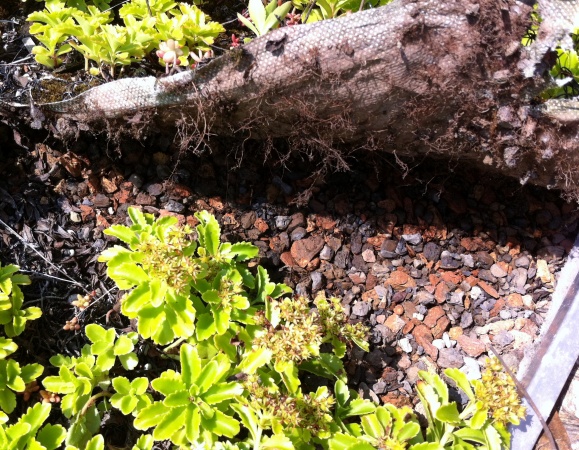Green roofs
Overview[edit]
Modern green roofs are a rapidly developing commercial market in Ontario. Their primary benefit as a LID technology is in maximizing evapotranspiration for water balance targets. Green roofs are sometimes referred to as 'ecoroofs', 'vegetated roofs', 'living roofs'.
Green roofs are ideal for:
- Sites without significant space at ground level for infiltration,
- Zero-lot line projects with outdoor amenity requirements,
- Projects looking for accreditation with LEED v.4
Extensive green roofs are the most commonly used type of green roof used for stormwater in our region.
| Property | Extensive | Intensive |
|---|---|---|
| Planting medium depth | 10 - 15 cm | > 15 cm |
| Loading | up to ~250 kg/m2 | Limitless where 'roof' is at ground level |
| Cost | Low | High |
| Maintenance | Depends highly on the aesthetic expectations of stakeholders | Will be comparable to other landscapes, depending on access requirements. |
| Stormwater benefit | Provides best cost-benefit balance | Will vary highly |
| Biodiversity benefit | Limited | High |
| Amenity benefit | Usually visual only i.e. inaccessible | Often accessible |
Intensive green roofs are commonly used for amenity space on condo developments or sometimes as urban farms. They are sometimes referred to as roof gardens and encompass diverse uses, design priorities and technical specifications. In the most extreme examples, many urban parkettes including large shade trees may be included in this class, if they have parking garages beneath. As such the discussion on this page is limited to extensive green roofs.8
The fundamental components of an extensive green roof are:
- a roof able to withstand the load
- a roof membrane resistant to root penetration
- a drainage layer
- a filter layer
- a layer of planting medium
- plants
Additional components may include:
- an irrigation system
- pre-formed tray modules
Planning Considerations[edit]
Green roofs offer a variety of co-benefits beyond stormwater management. In urban centers they are often constructed to accommodate a roof terrace or amenity space. In this scenario the direct stormwater capture benefit is restricted to the areas with vegetation planted. Another increasingly popular use for rooftop space is for urban farming. Again, the direct stormwater capture benefit is restricted to the areas with planters. To maximize the utility of a green roof as a low impact development tool, coverage with planting should be maximized. In many cases this means only inaccessible spaces are used.
Amenity
Roof gardens with a high proportion of impermeable surface are popular in high rise developments. These amenity terraces are often described as green roofs, but the LID benefit applies only to the vegetated areas. The stormwater benefit of all kinds of green roofs is maximized by combined with rainwater harvesting for subsequent irrigation. Sedum and native species have all been shown to thrive with daily irrigation to saturation[1].
Rooftop farming is also becoming common in some Ontario cities. Again consideration should be given to the proportion of the roof actually planted. Where large open expanses of roof are being cropped, measures may be required to reduce erosion of exposed planting medium. Any digging or furrows will reduce the stormwater benefit.
Biodiversity
Biodiversity opportunities are optimized by planting a variety of species. General advice on this has been prepared by the City of Toronto[2]. In the long term, the richness of species increases owing to 'volunteer species'. The desirability of this diversity varies with the aesthetic concerns of the green roof owner.
Design for Maintenance
Detailed inspection and maintenance advice can be found in Sustainable Technologies' LID I&M guide.
The primary operational concern for operating a green roof is the development of a leak. Green roofs protect the roof membrane from UV damage and should increase the lifespan of the roof. However, in the event that a leak is discovered a section of green roof would have to be removed for access. Some proprietary systems appear to be easier to remove and replace. This may come at a cost, as the rainwater retention of the system is somewhat reliant on continuous coverage of the green roof surface.
Green roofs should receive as little maintenance as possible. Regular inspection is only required to see that the drains are free from obstruction and that the vegetation coverage is adequate to prevent wind erosion. During detailed design, all areas adjacent to the green roof itself should be kept free from granular material. Sediment accumulates in gravel edging, which then permits the vegetation to take root and spread.
- ==Design==
- Extensive green roofs do not require additional insulation layers. The underlying roof may be of warm, cold or inverted design.
- An alternative drainage layer solution is to use a granular medium to increase the tortuosity of the flow path and slow peak flow rates.
- Maximizing evaporation with spray irrigation is the faster way to empty a stormwater cistern, and provides some cooling benefit for the building and it's surroundings.
</panelSuccess> <panelInfo>
</panelInfo>
Performance[edit]
Water quantity
Green roof performance has not been reported to reduce over time. Controlled studies have instead indicated that maturing green roofs may have improved water retention properties [3].
Water balance
Peak flow control
Water quality
<panelWarning>
</panelWarning>
Incentives and Credits[edit]
In Ontario
City of Toronto updated their 'Eco roof' incentive program in 2017 . It now includes grants for structural assessment and is available to non-profit organisations [4].
LEED BD + C v.4
LEED offer a relatively large number of points for green roofs compared to other LID technologies.
Sustainable Sites: Open space (1 point) This credit applies to accessible green roofs on tall buildings with little other outdoor space[5].
Sustainable Sites: site development - protect or restore habitat (up to 2 points) This credit applies to green roofs planted with 'native and adapted vegetation' on tall buildings with little other outdoor space[6].
Sustainable Sites: Heat island reduction (up to 2 points) Green roofs are weighted as effectively as 'High-Reflectance' roofs in a simple calculation to determine the credit[7].
Sustainable sites: Rainwater management (up to 3 points)
- Two points (or 1 point for Healthcare) will be awarded if the project manages "the runoff from the developed site for the 95th percentile of regional or local rainfall events."
- Three points (or 2 points for Healthcare) will be awarded if the project manages "the runoff from the developed site for the 98th percentile of regional or local rainfall events."
OR
- For zero-lot-line projects only, 3 points (or 2 points for Healthcare) will be awarded if the project manages "the runoff from the developed site for the 85th percentile of regional or local rainfall events."
SITES v.2
External Links[edit]
Proprietary Systems
In our effort to make this guide as functional as possible, we have decided to include proprietary systems and links to manufacturers websites.
Inclusion of such links does not constitute endorsement by the Sustainable Technologies Evaluation Program.
Lists are ordered alphabetically; link updates are welcomed using the form below.
